EOS R6 Mark II: Canon’s New Gamechanger for Hybrid Shooters
On 2 November 2022, Canon announced the EOS R6 Mark II. While the new camera is the successor of the popular EOS R6 in name, it is packed full of improvements and enhancements that make it a notable new camera in its own right.
Powerful photography and video features in one full-frame mirrorless body
Powerful photography and video features in one full-frame camera body
The EOS R6 boasted fast, high-quality imaging made possible by the DIGIC X image processing engine and swift, reliable AF capabilities resulting from advanced, deep learning-based algorithms. All these are made even better on the EOS R6 Mark II, which boasts major improvements to many of its fundamental features.
Notable new features include:
- 6K RAW video external recording
- Up to 40 fps continuous shooting (electronic shutter)
- A newly developed 24.2-megapixel CMOS image sensor
Through these and many more, the EOS R6 Mark II seeks to be a camera model that satisfies both video and still shooters, regardless of your level of experience.
Up to 40 fps continuous shooting: Twice the megapixels, double the speed
Still photography: Up to 40 fps cropless high-speed continuous shooting
For still photography, one of the most notable improvements on the EOS R6 Mark II is the much higher maximum continuous shooting speed even with the higher-resolution, newly developed 24.2-megapixel image sensor—a feat made possible with the powerful DIGIC X image processing engine. At 40 fps, it is twice as fast as the EOS R6, and offers the fastest continuous shooting speed with AF/AE tracking in the entire EOS series*1.
(Note: The custom high-speed shooting function added to the EOS R3 by Firmware Version 1.2.1 achieves up to 195 fps with AF/AE lock.)
The EOS R6 Mark II also allows users to select intermediate continuous shooting speeds even in electronic shutter mode (H mode: max. approx. 20; L mode: approx. 5 fps), which might suit certain types of subjects better*2.
The maximum mechanical shutter continuous shooting speed is 12 fps with AF/AE tracking, equivalent to the EOS R6.
Two anti-flickering modes that cater to a wider range of situations
To ensure consistent exposure even when conducting continuous shooting in venues with high-frequency lights, such as LED lights and electronic signages, the EOS R6 Mark II includes a high-frequency anti-flicker function that works in all shutter drive modes (mechanical, electronic, electronic first-curtain, and movie). This counteracts high-frequency flickering of 50.0Hz to 8192Hz (mechanical and electronic first-curtain shutter: up to 2048Hz), and complements the existing anti-flicker shooting mode, which works only in mechanical shutter mode and counteracts lower frequency flickering of 100 to 120 Hz.
The camera’s fastest shutter speed is 1/8000 seconds in mechanical shutter mode, and 1/16,000 seconds in electronic shutter mode—the latter twice the speed of the EOS R6*3.
*1 As at 2 November 2022.
*2 The actual continuous shooting speed depends on various factors such as battery type/remaining charge, temperature, built-in Wi-Fi. (‘On’ or ‘Off’), flicker reduction, shutter speed, aperture value, type of lens, etc. For more information, please refer to the user manual.
*3 During electronic shutter shooting, rolling shutter distortion may occur depending on the subject, shooting conditions, and conditions such as flash photography incompatibility.
RAW burst mode: Capturing the moments before shutter release
The EOS R6 Mark II is the first EOS full-frame camera to feature the RAW burst mode, where a sequence of images is shot using the electronic shutter at up to 30 fps* and saved in one file. If the pre-shooting mode is enabled, the camera records the moments up to approximately 0.5 seconds before the shutter is released, increasing the chances of capturing unexpected moments that happen right before the photographer can react.
*AE is fixed at first shot. SD card with Speed Class 10 or above is recommended. Normal recording may not be possible if the battery level is low or the SD card has a slow writing speed.
Note: Interval required between consecutive RAW burst sequences: approx. 27 sec on a normal SD card (UHS-I); approx. 12 sec on high-speed cards (UHS-II).
New subject detection capabilities: Horses, trains, aeroplanes and helicopters
New subject detection capabilities: Horses, trains, aeroplanes and helicopters
The EOS R6 Mark II adds horses, trains, and aircraft (including aeroplanes and helicopters) to existing detectable subject types.
Users can also now configure Eye Detection AF to prioritise either the left or the right eye when photographing people and animals, ensuring AF outcomes that are a closer match to their shooting intent.
EOS R6 Mark II/ RF100-500mm f/4.5-7.1L IS USM/ FL: 500mm/ Manual exposure (f/7.1, 1/1600 sec)/ ISO 800/ WB: Auto
Subject detection modes and parts detected
|
|
|
|
| Humans | Eyes (left/right priority)/ Face/ Head/ Torso | |
| Animal | Dogs, cats, birds, horses | Eyes (left/right priority)/ Face/ Torso |
| Vehicle | Motorsports (Cars, motorcycles) |
Vehicle body/ Helmet |
| Trains | Whole body/ Front carriage | |
| Aeroplanes, helicopters |
Full body/ cockpit | |
| Auto | All the above | All the above |
For scenes where multiple types of subjects may appear, using the “Auto” subject detection mode allows the camera to detect all the subjects regardless of type and intelligently select the main subject.
Tracking with animal detected
(horse)
Tracking with vehicle detected
(aeroplane)
The fundamental subject detection mechanics are equivalent to those on the EOS R3. For more information, see:
Subject detection via deep learning; tracking via EOS iTR AF X
Enhanced tracking and AF performance
Leave focusing to the camera: Improved tracking reliability based on deep learning technology:
The EOS R6 Mark II inherits the new tracking concept introduced on the EOS R3, where deep learning-based tracking is available in all eight AF area modes. As the improved EOS iTR AF X can detect subjects by extracting their characteristics, subject detection and tracking is possible in scenes previously considered challenging, such as those with changes in brightness or where the parts of the subject are not visible.
With tracking and focusing more consistent and reliable in even in situations such as sports and wildlife photography, users can concentrate on other aspects like timing and composition, and leave the focusing to the camera.

For more control over focusing, there are 8 AF area modes available. Besides the default whole area AF mode, the other 7 are:
- 1-point AF
Allows users to choose from up to 4897 different AF point positions.
- Spot AF
Offers an even smaller AF area than 1-point AF for pinpoint focusing.
- Two Expand AF area modes:
Expand AF area (above, below, left and right) and Expand AF area (around) use the 1-point AF point and 4 (or 8) AF points surrounding it for more flexibility when focusing on moving subjects.
- 3 Flexible Zone AF modes
First introduced on the EOS R3, on the EOS R6 Mark II, users can set an AF area of their desired size ranging from 9 points (3×3) to 999 points (37×27) and store them in up to 3 slots.
Newly developed 24.2MP image sensor: Quality beyond the megapixels
Newly developed 24.2MP CMOS image sensor; sharpness beyond the megapixel resolution
The EOS R6 Mark II is equipped with a newly developed 24.2-megapixel full-frame CMOS image sensor, allowing users to take the fullest advantage of ultra-wide-angle lenses. The full-frame image sensor also makes it easier to achieve images with a shallow depth-of-field and excellent background separation.
EOS R6 Mark II/ RF70-200mm f/2.8L IS USM/ FL: 135mm/ Manual exposure (f/5.6, 1/125 sec)/ ISO 100/ WB: 5300K

In addition to the increase in megapixel resolution over the EOS R6’s approximate 20.1 megapixels, the EOS R6 Mark II’s new image sensor is equipped with new sharpness processing capabilities, which further improves resolution and the rendering of details. Canon’s tests have shown that the EOS R6 Mark II achieves visual resolution equivalent to that of the 30.4-megapixel EOS 5D Mark IV*.
24.2 megapixels is more than sufficient for making A3 commercial prints—perfect for users who enjoy making large prints of their works.
*Based on ISO 12233 compliant CIPA resolution chart evaluation and default Picture Style conditions.
Digital Lens Optimizer and DPRAW: Ensuring the best image quality straight out of camera
Like other EOS R series cameras, the EOS R6 Mark II is equipped with the in-camera Digital Lens Optimizer and Lens Aberration Correction features, which use lens design data to digitally correct distortion, chromatic aberration, diffraction, vignetting, and other aberrations inherent to various lenses, resulting in images with the best possible quality.
Support for DPRAW shooting enables users to make slight adjustments to shooting angle and resolution when developing the image with Canon’s native, free-to-use Digital Photo Professional (DPP) software. Portrait Relighting and Background Clarity adjustment are also available with in-camera RAW processing.
Like the EOS R3, the EOS R6 Mark II harnesses deep learning technology to achieve improved AWB (auto white balance) accuracy.
New HDR ‘Moving Subject’ mode; enhanced creative possibilities
Like the other “second generation” EOS R cameras, the EOS R6 Mark II supports HDR PQ 10-bit HEIF still shooting in addition to the usual RAW and JPEG formats. It also features a new ‘Moving Subject’ HDR mode, which achieves a shot with a wider dynamic range (JPEG/HDR PQ) in one exposure instead of the usual three merged bracketed exposures. This provides a solution to the challenge caused by moving subjects changing positions in between bracketed exposures, allowing a convenient way of creating HDR images of sports, animals, vehicles, and other moving subjects, even while panning.

EOS R6 Mark II/ RF400mm f/2.8L IS USM/ FL: 400mm/ Manual exposure (f/2.8, 1/125 sec)/ ISO 12800/ WB: Tungsten/ HDR Mode: Moving Subject
Other convenient creative functions
- Panorama Shot mode
- Focus bracketing + In-camera Depth Composition
- Multiple exposure
- Interval timer
- Special Scene modes (not available on the EOS R6)
- Creative filters (not available on the EOS R6)
Digital teleconverter: One-touch extra reach
Digital teleconverter: One-touch extra reach

Another feature debuting on the EOS R6 Mark II is the digital teleconverter, which digitally processes images to achieve an effect equivalent to a 2x or 4x zoom (2x or 4x the lens focal length), depending on the mode. Like a built-in extender, the function allows you to get closer without the need to change lenses.
Images shot in this mode are not simply cropped, but processed and upsized to the recording size, so shooting L-quality JPEG (6000×4000) in the 2x mode, for example, results in a final image that retains L-quality JPEG (6000×4000) pixel resolution*.
The digital teleconverter can be combined with the 1.6x crop function or RF-S/EF-S lenses to achieve even longer reach. The resulting angle of view is equivalent to approximately 3.2x or 6.4x the focal length, with an L-quality JPEG file size of 3744 × 2496.
Tip: Assign a shortcut to the digital teleconverter function
By assigning the digital teleconverter function to either the M.Fn or depth-of-field preview button, you can instantly enable the feature with just one touch of a button.
*The image quality will be reduced because the image is enlarged and recorded. JPEG shooting only. The AF frame is fixed at the centre point.
Up to 8 stops’ image stabilisation with Coordinated Control IS
In-Body IS; up to 8 stops’ image stabilisation with Coordinated Control IS

The EOS R6 Mark II is equipped with the sensor-shift type In-Body Image Stabilizer (In-Body IS), which corrects camera shake along 5 axes of movement, providing image stabilisation even for compatible EF/RF lenses with no built-in Optical IS. With compatible RF lenses equipped with Optical IS, the EOS R6 Mark II also supports Coordinated Control IS, where the camera and lens IS systems coordinate to perform more effective image stabilisation up to as much as 8 shutter speed stops’ equivalent on lenses like the RF24-105mm f/4L IS USM.
Video: 6K RAW external recording; Canon Log 3, High Frame Rate Full HD 180p
Video: Professional features that include 6K RAW external recording
Utilising the full width of its 24.2-megapixel image sensor, the EOS R6 Mark II is capable of 6K RAW video recording with an external recorder via a HDMI connection—sufficient to ensure high quality even with heavy post-processing and manipulation. In-camera, it can record high-quality cropless 4K video oversampled from 6K.
Besides conventional 8-bit YCbCr 4:2:0 recording, the EOS R6 Mark II also supports 10-bit YCbCr 4:2:2 Canon Log 3 and HDR PQ, providing ample recording options to support HDR video production, colour grading, and other advanced video post-production workflows.
Also see:
Videography FAQ: What do 4:2:2 and 4:2:0 mean?
Videography FAQ: What is Bit Depth? How Does It Affect My Video?
External RAW recording to ProRes RAW via HDMI output is possible with the ATOMOS Ninja V+.
High Frame Rate video at Full HD 180p
1/6 speed slow motion video, achieved with Full HD 180p recording, 30p playback
In Full HD mode, it is possible to achieve seamless slow motion video with High Frame Rate shooting. The EOS R6 Mark II provides a faster frame rate of up to around 180 fps/150 fps, which translates to video that is up to 6x slower when played back at 30p/25p.
New feature: Pre-recording for video
The new video pre-recording feature can record videos of moments that occur up to 5 seconds before the REC button is pressed. This removes the need to leave the camera recording, great for situations such as wildlife documentary where it’s hard to anticipate when video-worthy action will occur. It also streamlines the post-processing workflow, as you no longer need to edit out long durations of unnecessary footage!
New feature: Focus breathing correction
The EOS R6 Mark II newly supports focus breathing correction, which utilises optical design data to correct unwanted changes in angle of view that may occur when pulling focus. Combined with a compatible lens, the feature enables better control over focus transitions, helping video creators to capture footage that matches their creative intentions.
UVC/UAC compatibility: Livestream with high-quality video and audio, just by plugging in your camera
As the EOS R6 Mark II supports UVC (USB Video Class) and UAC (USB Audio Class), users can easily transmit high-quality Full HD 30p video and audio to their Windows or MacOS computer simply by connecting a USB cable*. No driver installation is needed. It’s a quick, convenient way to harness the benefits of a full-frame camera for livestreams and remote meetings!
* UVC/UAC communication scheme/speed: Hi-Speed USB (USB 2.0) only; remote-controlled PTP supports Super Speed USB (USB 3.2 Gen 2) or earlier version.
Longer continuous recording duration
The removal of the 30-minute recording limit allows the EOS R6 Mark II to record up to 6 hours (1.5 hours during 120p/100p recording; 1 hour during 180p/150p recording), excluding situations where recording stops due to overheating. Improvements to heat control enable unlimited recording up to cropless 4K UHD 30p/25p.
Other notable features
Dust- and drip-resistant body

Strong, lightweight magnesium alloy is mainly used for the EOS R6 Mark II’s internal structure, and its exterior is made of lightweight rigid polycarbonate resin. A dust- and drip-resistant design ensures reliability even in outdoor shooting conditions.
Dual SD card slots

Dual SD card slots allow simultaneous recording for backup.
Multi-Function Shoe

The EOS R6 Mark II features the same Multi-Function Shoe found on the EOS R3/R5 C/R7/R10, making it compatible with new accessories like the Speedlite EL-5.
5GHz Wi-Fi / Bluetooth

The camera is equipped with built-in 5GHz/2.4GHz Wi-Fi capabilities and IEEE802.11b/g/n/a/ac compatibility, allowing for faster, more reliable network connections. Remote shooting through the Camera Connect app is more convenient than before.
USB charging and power delivery

While the EOS R6 Mark II comes supplied with Battery Pack LP-E6NH, it is also compatible with Battery Packs LP-E6N and LP-E6. It can be powered through a compatible USB cable. With the LP-E6NH and LP-E6N, in-camera USB charging is also possible.
Battery Grip BG-R10 (sold separately)

Like the EOS R5/R6, the EOS R6 Mark II can be used with Battery Grip BG-R10 (sold separately). The Battery Grip improves ease of use during vertical shooting, and takes two batteries, increasing the number of shots possible before power runs out.
Sample images
EOS R6 Mark II/ RF70-200mm f/2.8L IS USM/ FL: 200mm/ Manual exposure (f/4, 1/500 sec)/ ISO 100/ WB: Auto
EOS R6 Mark II/ RF70-200mm f/2.8L IS USM/ FL: 200mm/ Manual exposure (f/2.8, 1/200 sec)/ ISO 800/ WB: Auto
EOS R6 Mark II/ RF15-35mm f/2.8L IS USM/ FL: 15mm / Manual exposure (f/11, 1 sec)/ ISO 100/ WB: Auto








































.png)
.png)
.png)



